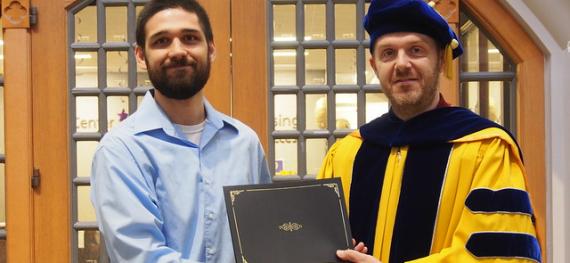By Craig Gin
In June I finished a three-year post doc in the Department of Applied Mathematics (Amath) at the University of Washington. It was an overwhelmingly positive experience. I enjoyed getting to know the faculty and students in the department and my teaching and research experiences prepared me well for my future career.
My primary responsibility during my time in Amath was teaching. I enjoyed teaching prior to arriving at the University of Washington, but there were several aspects of teaching in Amath that exceeded my expectations. First, I got to teach very talented students who were interested in the course content and engaged with the material. I was blown away by the quality of the questions I was asked in class and in office hours. I also got to teach really interesting courses. My previous teaching experience was in classes that are commonly known as “college algebra” so it was fun to teach more sophisticated mathematical content like dynamical systems, linear algebra, and computational methods for data analysis. I also enjoyed the freedom I was given in the Amath department. I was allowed to choose what I taught and given the freedom to try out alternative teaching styles and class structures.
I feel as though I am leaving the University of Washington as a much better teacher than when I arrived and that is mostly due to contributions of other members of the department. During most of my time in Amath I attended the Teaching College Mathematics Journal Club — a club founded and led by graduate students in which we read and discuss books and journal articles about pedagogy. In this club, I learned a lot about alternative teaching strategies like active learning, mastery-based grading, flipped classrooms, explicit learning goals, and much more. I was able to incorporate some of these ideas into my own teaching, often with the help of the graduate students in the teaching journal club. Of particular note are Ben Liu, Kelsey Marcinko, and Jeremy Upsal who at various times were my TAs and who worked with me to redesign aspects of the department’s beginning scientific computing course (Amath 301). I also benefited from concrete advice from experienced faculty like Mark Kot, Bernard Deconinck, and Nathan Kutz. They helped me navigate some of the tough decisions that I needed to make during the teaching process.
In addition to my teaching responsibilities, I was also given the opportunity to do research. The Amath department is a vibrant research community with many interesting areas of active research. During my PhD, I had done research in fluid dynamics, but because of all the interesting things happening in Amath I decided to use my post doc as an opportunity to enter a new area of research. I ended up working with Nathan Kutz and Steve Brunton on using deep learning to discover linearizing transformations for differential equations. When you are in a research meeting with Nathan and Steve, they produce a whirlwind of ideas and their excitement is contagious. Working with them was a joy. The machine learning skills that I learned from this research helped me secure my current job — a post doc at North Carolina State University where I am working with microbiome data. I know that the skills I obtained while in the Amath department will serve me well in my new job.
I appreciate the kindness of all the faculty, staff, and students throughout my time in Amath, and I will remember my time there fondly.
